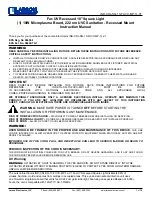
fungi and other deadly microbes. Moreover, far-UV light is considered to be eye and skin safe
for humans, as 222 nm UV rays cannot penetrate the skin to levels that cause burns or severe
damage. A 2018 study published in the US National Library of Medicine National Institutes of
Health
3
has proven that chronic irradiation with 222 nm far-UV lamps does not cause epidermal
lesions often associated with exposure to traditional 254 nm UV-C rays. This finding, among
others, revolutionizes the application of UV-C disinfection, allowing the lights to be deployed
safely in busy locations, occupied areas, manufacturing floors, restaurants, public buildings,
mass transit areas and more. Mercury-free excimer lamps with quartz glass are the artificial
light source of choice when implementing far-UV disinfection on surfaces.
Both far-UV 222 nm and conventional 254 nm have similar germicidal capabilities, but their
properties and behavior under varying conditions differ slightly. Notably, far-UV bands are not
readily absorbed by water vapor. UV 254 nm does not possess these qualities; however,
artificial light sources that emit 254 nm typically decline in effectiveness when exposed to
temperatures above 40°C for extended periods of time. Far-UV 222 nm artificial light sources
are compact, energy efficient and mercury-free.
As both UV bands utilize the same mechanism when deactivating bacteria and viruses, other
factors must be considered when choosing between far-UV 222 nm and conventional 254 nm
lamps. Such factors include the area of deployment (occupied or empty), distance of target
surface or area, access to UV lamp technology (to date, 222 nm excimer lamps are not readily
available in mainstream markets) and preferred method of disposal (traditional, mercury-based
254 nm UV lights are toxic and require sustainable disposal at the end of their lifecycle).
3.0 UV Light Sanitation
UV light contains special properties that deactivate the RNA and DNA of harmful microbes. The
UV-C range of 200 nm to 280 nm is responsible for this germicidal mechanism. Both far-UV 222
nm and traditional 254 nm bands are included in this germicidal range.
3.1 How Does UV-C Light Disinfection Work?
UV light consists of three primary wavelength ranges: long-wave UV-A (315nm to 400nm),
medium-wave UV-B (280nm to 315nm) and short-wave UV-C (200nm to 100nm), as defined in
ISO-21348 Standard
4
. In outdoor environments, UV-C is completely absorbed by the ozone
layer of the Earth’s atmosphere. This UV range is known as the germicidal range due to its
ability to deactivate viruses and bacteria (UV-A and UV-B do not have the capabilities
–
because
of this, the focus of the paper is the UV-C range). UV-C light can be generated by artificial light
sources, such as excimer, mercury vapor and fluorescent lamps. This technological
advancement ushered the widespread application of UV disinfection, allowing UV-C light to be
used in buildings.















